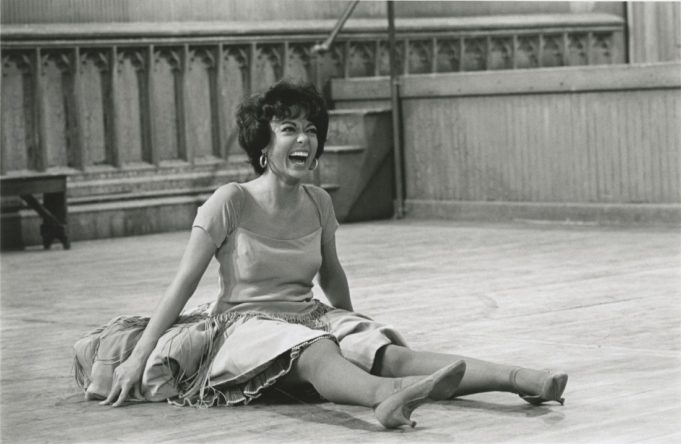This week, the main new things at the multiplex are two documentaries about two very different musical careers and the ups and downs they’ve had over the decades. Rita Moreno won an Oscar in 1962, and by all rights that should have led to mainline Hollywood stardom. It didn’t, because the industry had no idea what to do with a Latina actress in the early 1960s, even one who was manifestly talented at many things, even one who could pass for white (which she did in her small role in Singin’ in the Rain), even one who was young, attractive, and sexy. Many people would become discouraged under those circumstances, but she kept plugging away. Now Rita Moreno: Just a Girl Who Decided to Go for It looks back on her remarkable achievements.
Unvarnished truth is what this film is about, and it goes beyond seeing the star without her makeup and wig. The documentary shows us her early roles, when her skin was darkened with “makeup the color of mud” in her words so that she could play Polynesians, Asians, and Native Americans. It wasn’t just that these parts erased her ethnicity, but rather that they were all essentially the same, the colored girl who is the white man’s side piece before he goes off to marry the demure, respectable white woman. Perversely, Anita in West Side Story was the first role where she played a Puerto Rican.
Moreno talks of being raped by her agent and then letting him continue to work as her agent. She had a years-long abusive relationship with Marlon Brando, in which she became pregnant by him in an attempt to make him marry her. Instead, he arranged for an illegal abortion that almost killed her. Later, she would try to kill herself over him. The whole affair did one good thing for her, though, as his passion for social causes inspired her to speak out similarly for racial justice and abortion access.
As you’d expect, a murderer’s row of Latin celebrities (Lin-Manuel Miranda, Eva Longoria, Gloria Estefan, Gina Rodriguez, and even Supreme Court justice Sonia Sotomayor) lines up to say how she inspired them. Quite a few of them first saw her on the kids’ TV program The Electric Company, where she found something close to artistic freedom in a format that allowed her to play all sorts of roles. The best insights come from the film scholars who detail the difficulties facing a Latina actress during her time and from Hector Elizondo, the Puerto Rican contemporary who notes that the considerable difficulties he faced were nothing compared to hers.
As I post this, Rita Moreno is back in the headlines weighing in on In the Heights. The film makes clear that she won’t leave an opportunity to speak her mind, having done so too much early in her life. She refers to this part of herself as “Rosita,” the insecure little Puerto Rican girl who needs to entertain people to win their approval. Rosita has made Rita miserable for long stretches, but she’s probably also the reason why Rita has achieved so much. Director Mariem Pérez Riera doesn’t try to do too much, simply sitting back as Moreno films the Netflix remake of One Day at a Time and her part in Steven Spielberg’s upcoming redo of West Side Story. If you live long enough, everything comes back around, and Moreno still has a lucid mind and can still bust out some dance moves. She turns 90 this year. She’s an inspiration to us all.

If Pérez Riera doesn’t do too much in her documentary, Edgar Wright does a hell of a lot in The Sparks Brothers, his profile of the uncategorizable pop duo that has befuddled and dazzled its fans since the 1970s. Anyone who has seen Wright’s brilliant action comedies will expect this movie to be extraordinarily well-edited, which it is. Alas, it too often comes off like a mash note from a fanboy, albeit a brilliant one.
Sparks are Ron and Russell Mael, a Hollywood commercial artist’s sons who became interested in music while studying at UCLA. Many people believe that they’re English, since their records first became popular in the U.K., and the two have a whimsical, schoolboy sense of humor that fits with their British contemporaries: the Beatles, Monty Python, Douglas Adams. They make fun of the journalistic process in the beginning of the film with their deadpan answers to Wright’s questions. (How did you first meet? “We are brothers.” What is your sexual persuasion? “Slightly horny.” How many Sparks albums will there be? “With advances in medical technology, hopefully there will be two to three hundred more Sparks albums.”)
If the film plays like a hyperventilating music nerd forcing you to sit down and listen to this cool band that nobody else knows about, I will admit that I’d never heard of Sparks prior to seeing this. Having been forced to listen, I found them intelligent, subversive, and endearingly zany crafters of songs, with a near-phobic aversion to repeating themselves. This last tendency can be frustrating to a fan or a record executive, but it has kept them from going stale like so many other bands. Wright notes that Sparks were doing electro-pop in 1979, before every group had a synth.
Wright illustrates their story through interludes that have been animated in a variety of styles, as well as black-and-white interviews with Sparks’ lineup of celebrity fans, both musicians (Beck, Flea, Jack Antonoff, Weird Al Yankovic) and non-musicians (Neil Gaiman, Mike Myers, Patton Oswalt, Amy Sherman-Palladino). They and the Maels paint a compelling portrait of a band that has followed its creative star regardless of what the fans wanted or what other bands were doing.
The director probably could have done this at less than 140 minutes, and without analyzing every single one of Sparks’ 25 albums. All the director’s skill behind the camera and in the editing room can’t balance his desire to take us through his record collection. If he had staged a shootout in the middle of things, it would have usefully broken things up in a very Sparks (and very Edgar Wright) way. As it is, the movie is too balky.
Wright does document the brothers’ repeated thwarted attempts to break into filmmaking, which has interested them since their UCLA days. However, you can see Sparks’ long-delayed filmmaking debut later this summer, as they wrote the script and the songs for the musical Annette, directed by the mad French genius Leos Carax. If you want an appetizer for that movie or simply want to add some sophisticated songs to your playlist, The Sparks Brothers will do for you.
Rita Moreno: Just a Girl Who Decided to Go for It
Starring Rita Moreno. Directed by Mariem Pérez Riera. Rated PG-13.The Sparks Brothers
Starring Ron and Russell Mael. Directed by Edgar Wright. Rated R.












